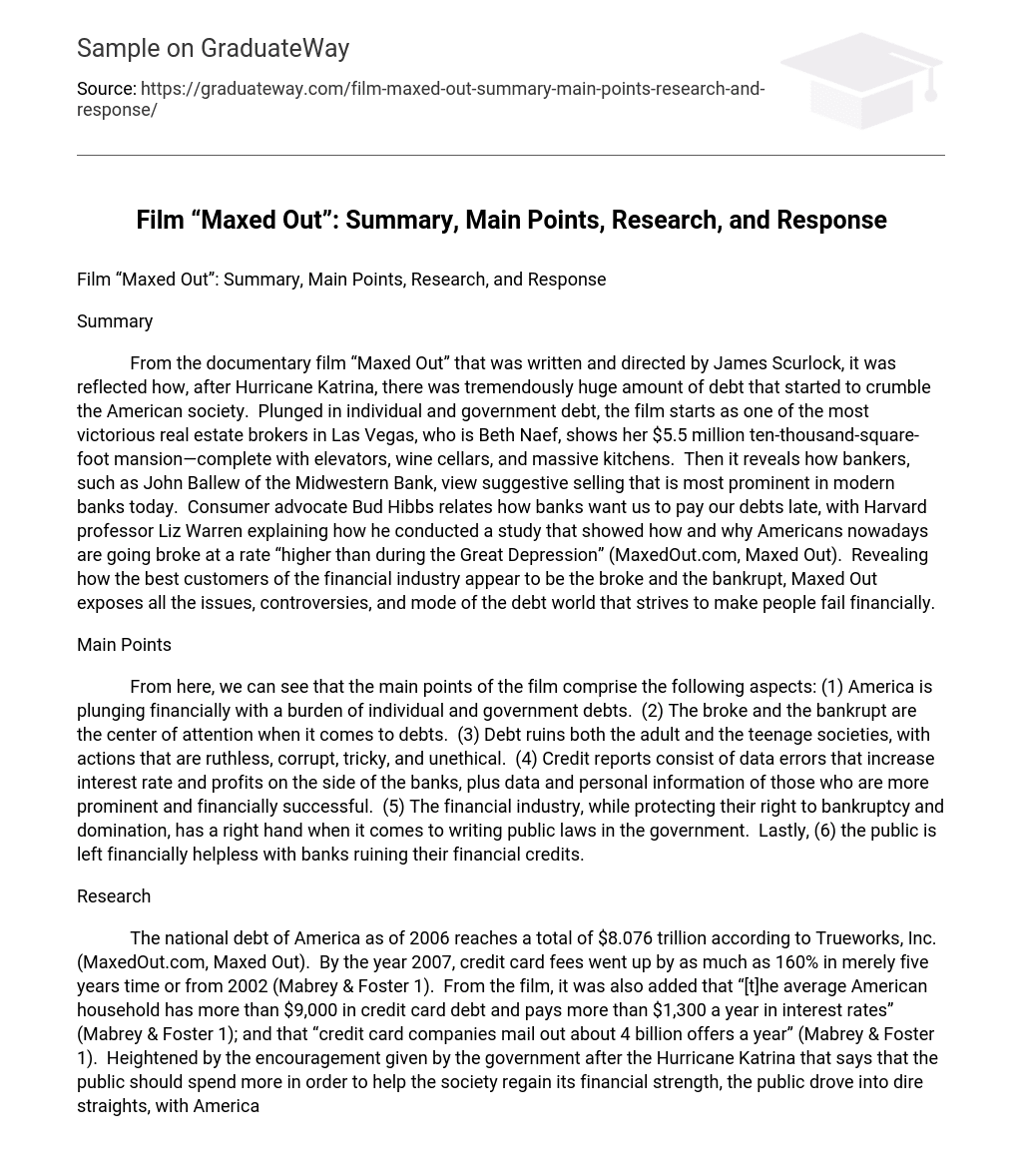Summary
From the documentary film “Maxed Out” that was written and directed by James Scurlock, it was reflected how, after Hurricane Katrina, there was tremendously huge amount of debt that started to crumble the American society. Plunged in individual and government debt, the film starts as one of the most victorious real estate brokers in Las Vegas, who is Beth Naef, shows her $5.5 million ten-thousand-square-foot mansion—complete with elevators, wine cellars, and massive kitchens. Then it reveals how bankers, such as John Ballew of the Midwestern Bank, view suggestive selling that is most prominent in modern banks today. Consumer advocate Bud Hibbs relates how banks want us to pay our debts late, with Harvard professor Liz Warren explaining how he conducted a study that showed how and why Americans nowadays are going broke at a rate “higher than during the Great Depression” (MaxedOut.com, Maxed Out). Revealing how the best customers of the financial industry appear to be the broke and the bankrupt, Maxed Out exposes all the issues, controversies, and mode of the debt world that strives to make people fail financially.
Main Points
From here, we can see that the main points of the film comprise the following aspects: (1) America is plunging financially with a burden of individual and government debts. (2) The broke and the bankrupt are the center of attention when it comes to debts. (3) Debt ruins both the adult and the teenage societies, with actions that are ruthless, corrupt, tricky, and unethical. (4) Credit reports consist of data errors that increase interest rate and profits on the side of the banks, plus data and personal information of those who are more prominent and financially successful. (5) The financial industry, while protecting their right to bankruptcy and domination, has a right hand when it comes to writing public laws in the government. Lastly, (6) the public is left financially helpless with banks ruining their financial credits.
Research
The national debt of America as of 2006 reaches a total of $8.076 trillion according to Trueworks, Inc. (MaxedOut.com, Maxed Out). By the year 2007, credit card fees went up by as much as 160% in merely five years time or from 2002 (Mabrey & Foster 1). From the film, it was also added that “[t]he average American household has more than $9,000 in credit card debt and pays more than $1,300 a year in interest rates” (Mabrey & Foster 1); and that “credit card companies mail out about 4 billion offers a year” (Mabrey & Foster 1). Heightened by the encouragement given by the government after the Hurricane Katrina that says that the public should spend more in order to help the society regain its financial strength, the public drove into dire straights, with American investors accumulating as much as $75 billion of bad debt alone as of the year 2006 (Mabrey & Foster 2).
Response
From what is being reflected in the film “Maxed Out,” it is a great indication on what people should be doing to not fall into this kind of financial trap by the debt purchasing industry. It is great to have this kind of documentary film, although I believe that the film has been all too one-sided and biased, as it failed to reflect the other side of the issue on how and why the government and financial industry encourage public debt even to the broke and the bankrupt citizens. People should learn how to decide the right amount just in case we have to have debts. Just to be safe, there should not be too much debt in the banks for people who are not very sure about the consequences. This film is great in the thought that watchers get a view of what might just happen to them if they have too much debt in their bank accounts.
Works Cited
Mabrey, Vicki, and Mary Claude Foster. “Maxed Out: Debt in America: New Documentary Takes a Harsh Look at the Credit Card Industry.” 14 March 2007. ABC News: Nightline. 18 October 2008 <http://abcnews.go.com/Nightline/story?id=2951203&page=1>.
MaxedOutMovie.com. “Maxed Out.” N.d. 18 October 2008 <http://www.maxedoutmovie.com/syn/index.html>.





